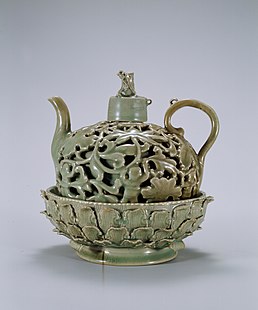
Back الفن الكوري Arabic Art coreà Catalan Arte coreano Spanish هنر کرهای Persian Art coréen French Korea művészete Hungarian Kesenian Korea ID Arte coreana Italian 朝鮮美術 Japanese Kesenian Korea JV
| History of art |
|---|
Korean arts include traditions in calligraphy, music, painting and pottery, often marked by the use of natural forms, surface decoration and bold colors or sounds.
The earliest examples of Korean art consist of Stone Age works dating from 3000 BC.[1] These mainly consist of votive sculptures and more recently, petroglyphs, which were rediscovered.
This early period was followed by the art styles of various Korean kingdoms and dynasties. Korean artists sometimes modified Chinese traditions with a native preference for simple elegance, spontaneity, and an appreciation for purity of nature.
The Goryeo dynasty (918–1392) was one of the most prolific periods for a wide range of disciplines, especially pottery.
The Korean art market is concentrated in the Insadong district of Seoul where over 50 small galleries exhibit and occasional fine arts auctions. Galleries are cooperatively run, small and often with curated and finely designed exhibits. In every town there are smaller regional galleries, with local artists showing in traditional and contemporary media. Art galleries usually have a mix of media. Attempts at bringing Western conceptual art into the foreground have usually had their best success outside of Korea in New York, San Francisco, London and Paris.
- ^ Lin, Nancy (2016). "5,000 Years of Korean Art". History of Collections. 28 (3): 383–400. doi:10.1093/jhc/fhv047.
© MMXXIII Rich X Search. We shall prevail. All rights reserved. Rich X Search
